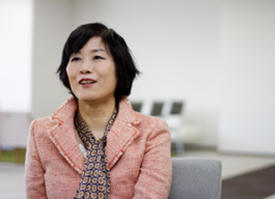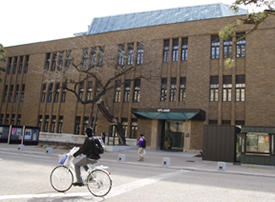

05/28/2012
The AIMR was founded in 2007 as one of the original WPI centers under an initiative of the Ministry of Education, Culture, Sports, Science and Technology of Japan and administered by the Japan Society for the Promotion of Science. In just a few years the institute has established itself as a leading center of materials research in Japan and is building a growing international reputation. Now entering its sixth year, the AIMR is about to embark on a new phase of development with a unique and ambitious mathematics-oriented approach to materials science research. Motoko Kotani, an internationally acclaimed mathematician and the institute’s newly appointed director, talks to AIMResearch about the successes of the past and her vision for the future of the AIMR.

AIMResearch: The AIMR recently celebrated its fifth anniversary. As its new director, how do you see the institute developing over the next five years?
Researchers at the AIMR have produced exciting world-class research across a wide range of fields. Based on a long record of excellence in materials research at Tohoku University, the AIMR has taken a leading role in making important scientific breakthroughs in the fields of bulk metallic glasses and spintronics, as well as developing the areas of nanoporous materials and microelectromechanical engineering (MEMS). Using such achievements as a base, the AIMR is now looking to make the leap to the next level of research activity. The recent establishment of a mathematics unit will play a central role in this process. Until now, each of the research groups at the AIMR has concentrated on discovering new materials in their own unique fields of expertise, and they have been very successful in doing so. We now wish to discover new scientific principles based on a fundamental understanding of materials through fusion research. Mathematics will guide materials scientists in this approach by simplifying and giving uniform formulation for complex phenomena.
AIMResearch: You mention the increased use of mathematics in the work of the AIMR. How does the AIMR plan to integrate mathematics and materials science?
Bringing together materials science and mathematics is a unique and rather ambitious idea. Initially we will focus on using an integrated mathematics approach to investigate three target materials that have found recent research success: namely non-equilibrium materials based on mathematical dynamical systems; topological functional materials; and multiscale hierarchical materials based on discrete geometric analysis. These are all wide-ranging themes, and it will take some time to investigate each of them thoroughly. Although we have formed a number of study groups to identify immediate, mid- and long-term goals for each theme, achieving substantial progress may take five or ten years, or perhaps even longer.
AIMResearch: One of the goals of the AIMR is to become a research center that is visible on the world stage. To what extent has this been achieved and how will the AIMR continue to develop its international presence?
Becoming internationally visible is a common goal of all centers in the WPI program, and we’re doing pretty well in that respect. Surveys carried out by the Japan Society for the Promotion of Science indicate that name recognition of both the WPI program and the individual WPI centers is growing, and citation analysis shows that the number of WPI papers in the top 1% of cited research as a proportion of their total output is the second-highest in the world. The AIMR contribution to this achievement has been substantial; many of the papers we publish in top-level international journals go on to be highly cited. We appealed for international collaborators during development of the three new mathematics-driven materials research objectives I mentioned previously. Even though we set only a short window for applications, we had a very good response from scientists outside Japan who were interested in working with us. The AIMR also has 22 overseas partner universities including three satellite centers at the University of Cambridge, the University of California, Santa Barbara and the Chinese Academy of Sciences. We are in the process of creating joint laboratories with these institutions and are setting up more satellite centers to increase our international collaborations and broaden our global reach.
AIMResearch: The AIMR has the highest proportion of non-Japanese researchers among all six WPI centers. What is the secret to your success in this area?
All of our ‘principal investigators’ (PI) are extremely active in the international arena, which brings the work of our institute to the attention of a global audience. Another important factor is the longstanding pedigree of Tohoku University in materials research. Both of these factors are extremely helpful in attracting high-quality PhD students and postdoctoral researchers to the AIMR. We are proactive in recruiting outstanding scientists from overseas to participate in the work of the AIMR, and this helps us to attract more overseas students. Currently there are three types of foreign PIs: those who move here permanently to establish Japan as their main base of research; those who set up a sizable laboratory at the AIMR and spend several months a year here while maintaining a group in their home country; and those based at one of our partner universities abroad who send postdoctoral students to work on collaborative projects at the AIMR and thus form a bridge between the two institutions. Foreign PIs living abroad typically visit Japan once or twice a year to meet with their Japanese counterparts and discuss project progress. The joint laboratories at our satellite centers play an important role in facilitating academic exchange visits between the AIMR in Japan and partner institutions in foreign countries.

AIMResearch: One of the aims of the WPI movement is to change the academic culture of the center’s home institution. In this context, what influence has the AIMR exerted on Tohoku University?
Tohoku University understands the special approach that we take towards research at the AIMR. We have been given a lot of freedom to develop the kind of academic and organizational style that suits us as an institute. As a result we have implemented a number of new initiatives, such as introducing a merit-based pay system, allowing staff to hold dual affiliations — which is rather unusual in Japanese institutes — and have taken a number of innovative measures to make our research and pastoral support services more flexible and responsive to the needs of our staff and students. Our intention is to see how this knowledge can be applied to the working practices of Tohoku University as a whole. To that end we will supply the university with an extensive dossier of our experiences at the AIMR. We anticipate that many of the initiatives and protocols established over the past five years will be taken up by other parts of Tohoku University, such as the Disaster Control Research Center and the recently established Medical Megabank. We hope that the work of the AIMR will have a major impact not only on the Japanese university system, but also on the entire field of materials science.